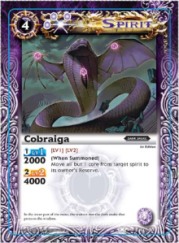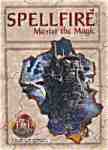Battle Spirits
This review was originally posted at Guilt-Free-Games.com.
Battle Spirits, the latest Collectible Card Game (CCG) by Bandai is beautiful. Face down, the cards look like an expensive set of playing cards. Flip the cards over and the card frames are intricate and lush. There’s some oddity about how the text boxes are spaced out, since many cards have a huge blank spot for a vanilla creature, then tiny flavor text… but at least the cards are uniform. When a card does have a lot of text, it fits without the text size shrinking.

An Example of Intricate Artwork
The downer is the actual card art. While many cards have excellent artwork, this is interspersed with obvious computer graphics. Who likes this stuff? CGI have come a long way, but rendered textures on 3-D models looks hokey.

An example of Burning your Face! LOL CGI 4 teh win!
The Battle Spirits starter also comes with 15 ‘pieces of core’ counters, which are sparkly blue, but aren’t very efficient to play with since they’re so small. They remind me of the tiny dice found in some miniatures games; It’s there so you can play the game as soon as you open it, but you’ll probably want to get a real set of counters soon.
While we’re on the pieces of core, let’s jump to resource management. I know, I know… intricate details of how one keeps track of their resources does not sound fun. It’s why we hire accountants. Battle Spirits pulls a nifty trick, though, so you may want to stick around for this.
Players begin with four cores in their reserve, and they use five cores to represent their life. When a player plays a card, they take a number of cores equal to that card’s cost and put them in the trash. Most cards also have a reduction cost for cards that are in play of that color. For example: Cobraiga costs four core and can be reduced by a maximum of three purple gems. If you have two card that have one purple gem on it in play (which practically all purple cards do), Cobraiga costs two core to put into play (4-2=2). It’s a neat way to reward people for staying in color, but also allowing them to play anything if they’re willing to pay full cost.
After a spirit comes into play, you need to level it up at least once, or it’s dead. You level up a spirit by putting a number of cores on it needed to reach the next level. When you start your turn again, you take all the cores in the trash, add one, and move them back to your reserve. Oh, and if someone deals damage to you or kills your spirit, you put the shard that represents one life or that creature’s level and move it to your reserve.
The resulting system hums. Players don’t end up with ‘mana screw’ like Magic, neither are they fated to play their one, two, three and four drops the same way every game as in the VS System. Also, shards ‘trapped’ in high level creatures and player life totals creates a natural come back mechanic and a reward for risky playing (If I let my opponent kill my creature, then deal damage to me, I’ll have more cores for next round…) If the system isn’t genius, it’s ingenious.
What has got to be the largest hurdle for Battle Spirits to vault is the ability to amass a large enough play network so that Joe Trading-Card-Player takes notice. Comic Book shops the world over is brimming with $1 packs of defunct trading card games. If Battle Spirits is to avoid becoming proxy cards for another game at the back of a binder, it needs to establish itself as more desirable to play than the industry leaders.

Don’t Laugh. It could happen to you.
While the mechanics of the game are stronger than most other CCGs on the market, the game is priced at $4 for a pack of eight cards with a chance that you might get some uncommons. For those who didn’t cringe when they heard that: “Congratulations upon reading this far into the article Yu-Gi-Oh! players! Keep at it, and someday you too may become an unpaid reviewer of games!”
It’s clear what model Battle Spirits is trying to emulate. There’s nothing, in theory, that’s wrong with Yu-Gi-Oh!.. assuming that you don’t mind that over 75% of their target audience doesn’t actually know how to play the game correctly. Yu-Gi-Oh! sells style. That’s how they sell a small number of tiny pieces of cardboard for the price of a pack of cigarettes.
But the game has been a hit in Japan for three years before it got printed in the states, so maybe this game won’t tank. Maybe there will be a new generation of CCG players that have matured away from Yu-Gi-Oh! and coin-flip-happy Pokemon and will graduate into an intelligent game that still fits their sensibilities of what a card game should look like. I sure hope so. I’d hate to see my play set of Duke Kingtaurus drop in value.




















